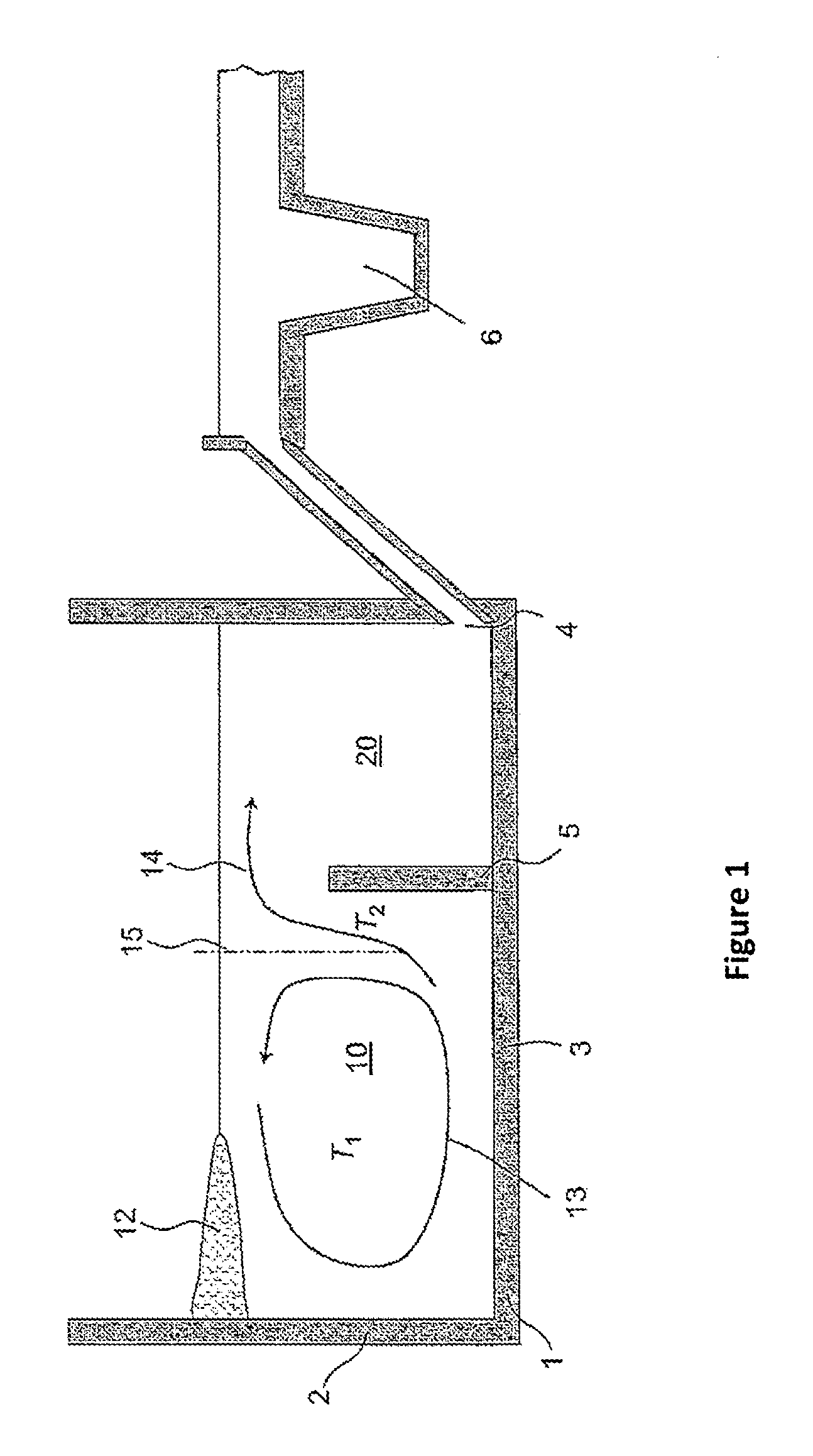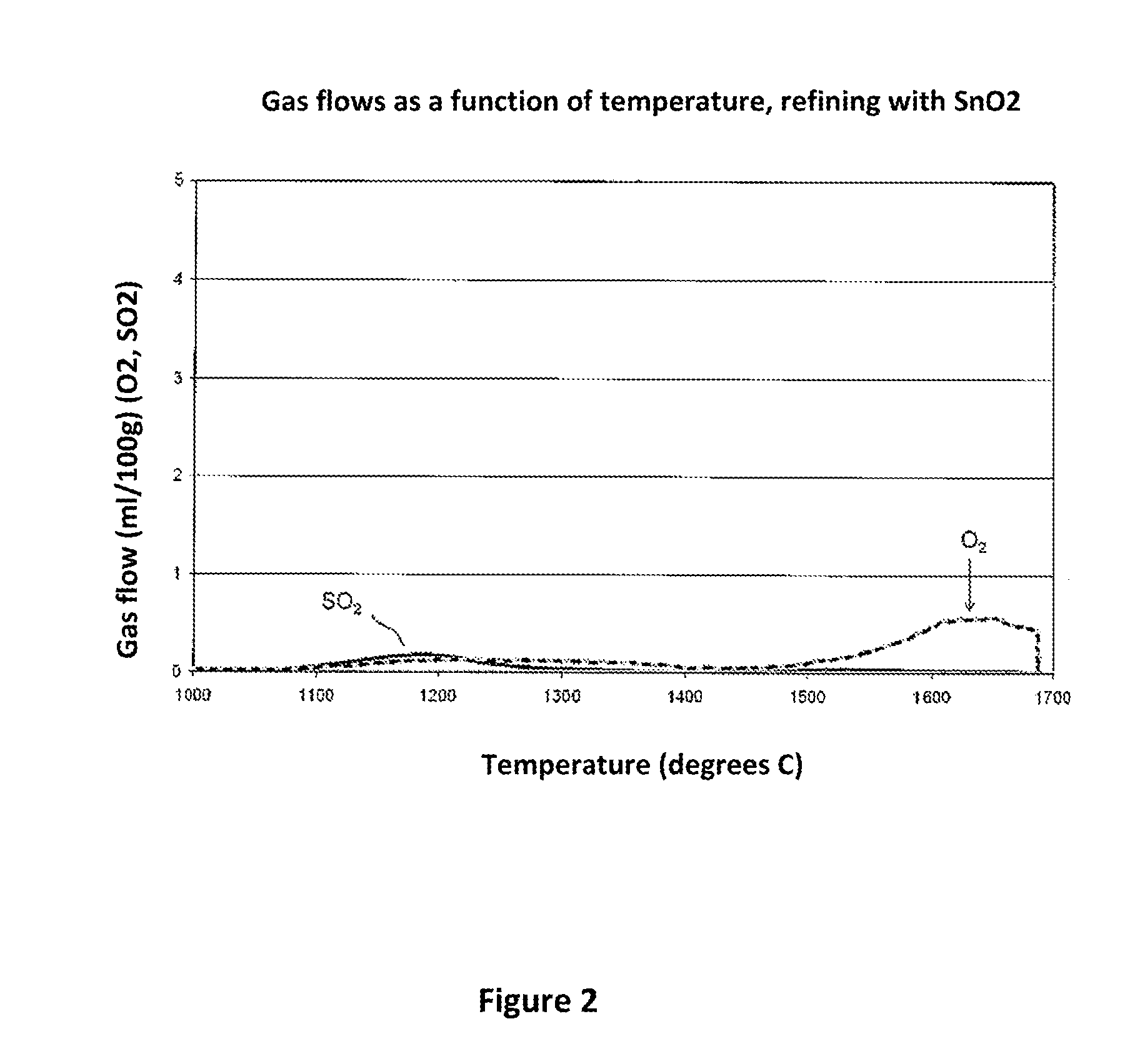Method for producing glasses, glass ceramics and the use thereof
a technology of glass ceramics and glasses, applied in the field of glasses production, can solve the problems of limited maximum permissible refining temperature, visible adverse effects on transmission and color, and layer to appear full of holes, so as to reduce transmission
- Summary
- Abstract
- Description
- Claims
- Application Information
AI Technical Summary
Benefits of technology
Problems solved by technology
Method used
Image
Examples
example i (
Small Furnace Tank)
[0127]An Nd2O3-containing LAS glass composition (composition 1) containing 0.25 wt. % SnO2 was melted in a small furnace tank. The batch contained 0.26 wt. % SO3, added as Ba sulfate. Commercial technical raw materials were used (quartz powder, Al2O3, Al hydroxide, Na nitrate, K carbonate, Li carbonate, MgO, TiO2, zirconium silicate, ZnO, Ca carbonate, Sr carbonate, Ba carbonate, Nd2O3, SnO2, Ba sulfate) with a total content of Fe2O3 of 0.02 wt. %. No coloring oxides were added to the batch. 0.4 wt. % Na2O was added as Na nitrate. After average melting temperatures of approximately 1580° C. to 1600° C. for the primary refining, the average melting temperature for the secondary refining was increased to 1640° C. The average residence times were >4 h in each case. Samplings after the furnace tank showed that the glass was melted free of remnants. The bubble concentration lay between 10 and 100 bubbles / kg each time, depending on melting parameters (melting temperatur...
example 2 (
Small Furnace Tank without High-Temperature Refining)
[0129]As in Example 1, the Nd2O3-containing LAS glass composition 1 was melted with 0.25 wt. % SnO2 and 0.26 wt. % SO3, added as Ba sulfate in a small furnace tank with comparable raw materials. The batch did not have any addition of coloring oxides. After average melting temperatures of approximately 1600° C. and average residence times of >5 h for the primary refining, the average melting temperature for the secondary refining was increased to approximately 1660° C. The average residence times were more than 3 h. The glass was melted free of remnants. The SO3 content after the furnace tank was less than 0.0012 wt. % and the bubble concentration (bubbles>100 μm) decreased in a stable manner to less than 2 bubbles / kg. A high-temperature refining was no longer necessary.
Example 3 (Laboratory Test with a Small Amount of SnO2)
[0130]In the gas furnace, a 1.4-kg batch of LAS composition 3 containing conventional technical raw materials...
example 5 (
Laboratory Colored Glass Ceramics)
[0138]In the laboratory, a 1.4-kg batch of LAS glass composition 5 containing conventional raw materials (quartz powder, Al2O3, Al hydroxide, K carbonate, Ca carbonate, Sr carbonate and Ba carbonate, Na nitrate, Li carbonate, petalite / spodumene, MgO, TiO2, zirconium silicate, ZnO, Nd2O3, SnO2, Ba sulfate) and 0.53 wt % SO3 refining agent as Ba sulfate was prepared.
[0139]The batch was melted without remnants in the gas furnace at temperatures of 1580° C. for 4 h and subsequently stirred in a 50-Hz heated coil in the silica glass crucible and kept for 3 h at 1640° C., in order to carry out a secondary refining. After the end of the melting time, the glass was poured and cooled at 20 K / h. Glass prepared in this way still contained approximately 300 bubbles / kg of glass. The analyzed SO3 content was 0.0015 wt. %. After the evaluation of the glass in the cold state, the glass was subjected to a high-temperature refining at 1860° C. with a residence time o...
PUM
| Property | Measurement | Unit |
|---|---|---|
| Time | aaaaa | aaaaa |
| Thickness | aaaaa | aaaaa |
| Temperature | aaaaa | aaaaa |
Abstract
Description
Claims
Application Information
 Login to View More
Login to View More - R&D
- Intellectual Property
- Life Sciences
- Materials
- Tech Scout
- Unparalleled Data Quality
- Higher Quality Content
- 60% Fewer Hallucinations
Browse by: Latest US Patents, China's latest patents, Technical Efficacy Thesaurus, Application Domain, Technology Topic, Popular Technical Reports.
© 2025 PatSnap. All rights reserved.Legal|Privacy policy|Modern Slavery Act Transparency Statement|Sitemap|About US| Contact US: help@patsnap.com



